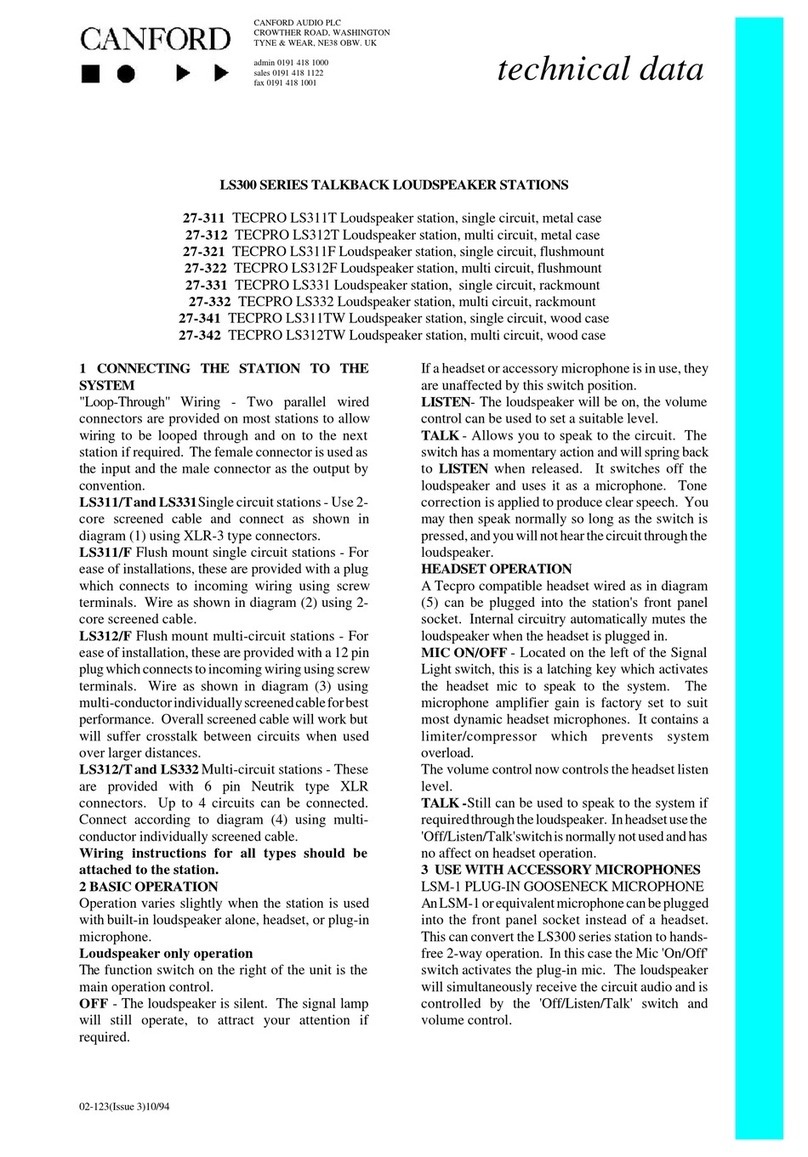CONNECTING THE BELTPACK TO THE SYSTEM
BASIC OPERATION
DETAILED OPERATION OF CONTROLS
Page 1
BP511 and BP531
This single circuit beltpack is connected to the system via the available male and female XLR 3 pin
connectors. By convention the female connector is used as the input and the male connector as the output
enabling the cabling to be 'looped through' to the next station, if required.
BP523 and BP543
This dual circuit beltpack is connected to the system via two 3 pin, female, XLR type connectors.
They are marked Circuit I and Circuit II. There is no ‘loop through’ capability.
BP525 and BP545
This dual circuit beltpack is connected to the system via male and female, XLR 5 pin connectors.
By convention the female connector is used as the input and the male connector as the output, enabling the
wiring to be ‘looped through’ to the next station, if required.
Headset operation
A Tecpro compatible headset, wired as in diagram 1or 2 (as appropriate), should be plugged into the 4 pin
XLR connector on the rear of the station.
Located on the front panel, the “MIC” button activates the headset mic to speak to the system when
depressed. The thumb operated volume control can be adjusted for a comfortable listen level.
Side-tone adjustment
The level of user’s voice in the headset is called 'side-tone'. The required level can be set by adjusting the
recessed side-tone control on the front panel with a small screwdriver.
Signal light operation
The CALL pushbutton flashes a light in all outstations connected to the circuit. It is used to attract the
attention of a user that has the headset removed or volume level turned right down.
ClearCom Compatibility
Tecpro stations are completely compatible with Clear-Com stations. Any Tecpro stations added to Clearcom
will function as their Clear-Com equivalents. However, Clear-Com stations have a lower bridging impedance
and will degrade a Tecpro system slightly due to a reduction in side-tone stability incurred when a Clear-Com
outstation is used in a Tecpro communications system.
The front panel houses the mic select and call buttons, headphone volume and side-tone adjust control(s).
Microphone Select
Press the “MIC” button briefly and it will illuminate green.This action switches on the mic circuitry and
allows the operation of other functions.
To switch off the mic circuitry press the “MIC” button briefly again.The lamp within the button will extin-
guish.
Holding the “MIC” button continuously keeps the mic circuitry alive for the duration of the press.
Call send
Ensure that a “MIC” circuit has been selected and that its associated lamp is illuminated.
Press the “CALL” button briefly.This will cause the lamps on all other beltpacks on the same circuit to flash
for approximately one second.The button will also illuminate red. A tone of similar duration will sound in
the headphones.
Remote Mic Kill send
Ensure mic circuits have been de-selected.
Depress the “CALL” button briefly three times. It will illuminate red for approximately two seconds.
During this time, briefly press the appropriate “MIC” button to switch off all mics on that circuit.

























